Take Me to the Recipes
Papua New Guinea is a country of immense cultural and biological diversity. Situated to the north of Australia, it comprises the eastern part of New Guinea, the second-largest island in the world, and a host of offshore islands.
With a climate that ranges from tropical in the coastal areas to cooler in the highlands, the country offers a variety of landscapes including lush rainforests, rugged mountains, and expansive river systems. The main industrial activities include agriculture, forestry, and fishing, which also influence the culinary traditions of the nation.
Home to roughly nine million people, Papua New Guinea boasts a tapestry of cultures, each with its unique contribution to the nation’s food dishes.
Papua New Guinean Cuisine – Key Takeaways
- Papua New Guinean cuisine is an eclectic mix of native roots and influences from its history of trade and colonization.
- The diet primarily includes starchy vegetables, sago, and fruits, along with pork, chicken, and seafood.
- Traditional cooking methods like ‘mumu’ – a pit oven cooking technique – are still prevalent.
- The abundant rainfall and fertile soil of Papua New Guinea contribute to the wide variety of fresh produce available.
- Recipes often feature ingredients like coconut, bananas, and sweet potatoes, staples in the local diet.
- The country’s diverse cultural fabric is reflected in the variety of dishes and preparation techniques.
You may also Enjoy the Following Articles
- North and South American Cuisine – A Culinary Expedition
- European Cuisine: Savor the Continent’s Best Culinary Secrets!
- African Cuisine: Discover the Bold Flavors & Global Charm!
- Asian Cuisine Unlock its Secrets – Taste, Health & Global Influence!
- Oceania Cooking: A Culinary Journey Through the Pacific
- Australian Cuisine – A Delightful Taste Adventure
Take Me to the Recipes
Where is Papua New Guinee?


Index to Contents
- Take Me to the Recipes
- Papua New Guinea Food History
- How Papua New Guinea’s Climate and Geography has influenced the Cuisine
- Understanding the Essence of Papua New Guinean Cuisine
- Papua New Guinea Food Culture
- Traditional Papua New Guinea Food
- Exploring Papua New Guinea’s Ingredients
- Papua New Guinea Food Easy Recipes
- Conclusion
- FAQ’s
Savor iconic Papua New Guinean Cuisine – Click on each tantalizing picture to open up the Recipe
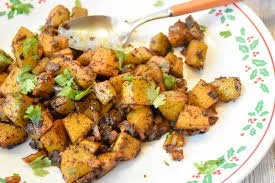
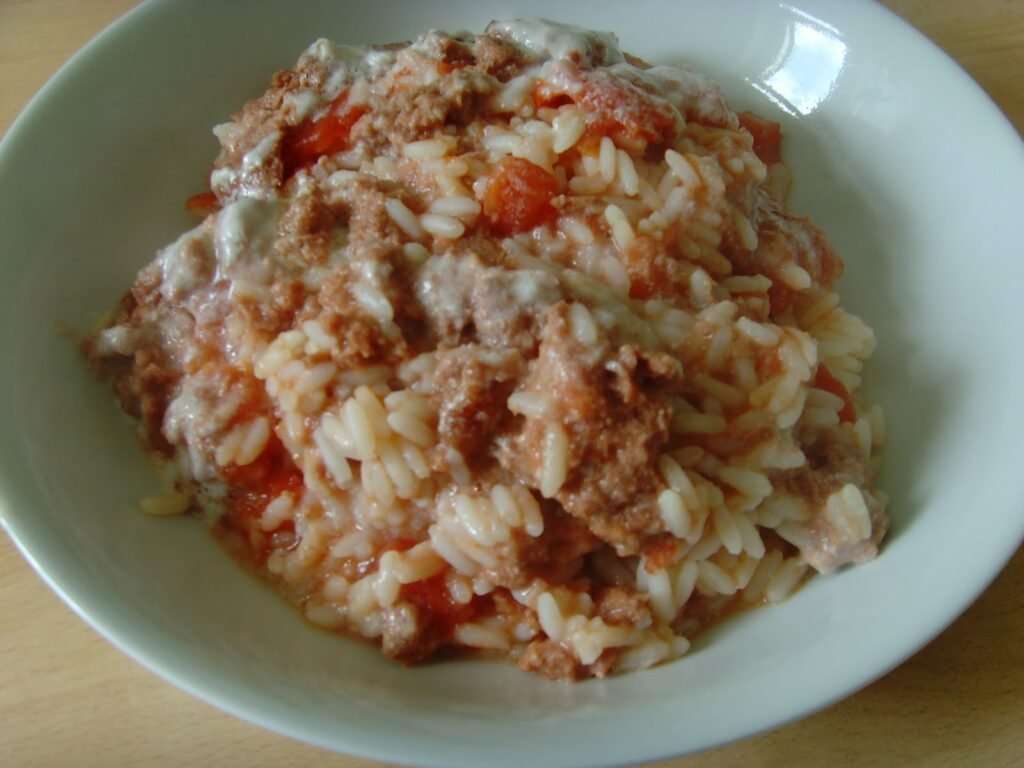
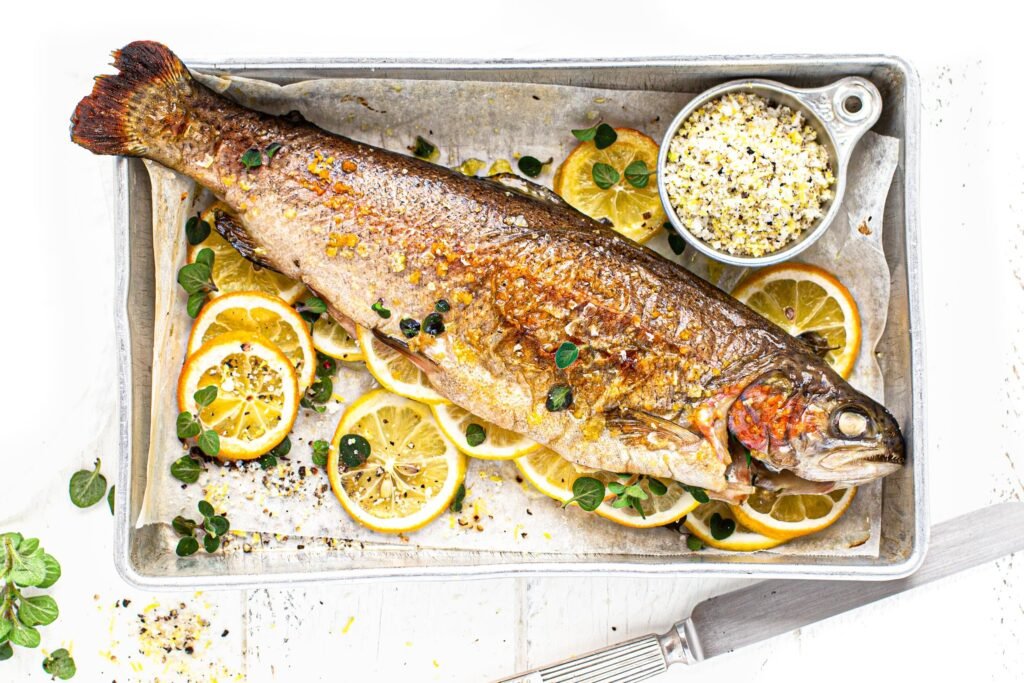
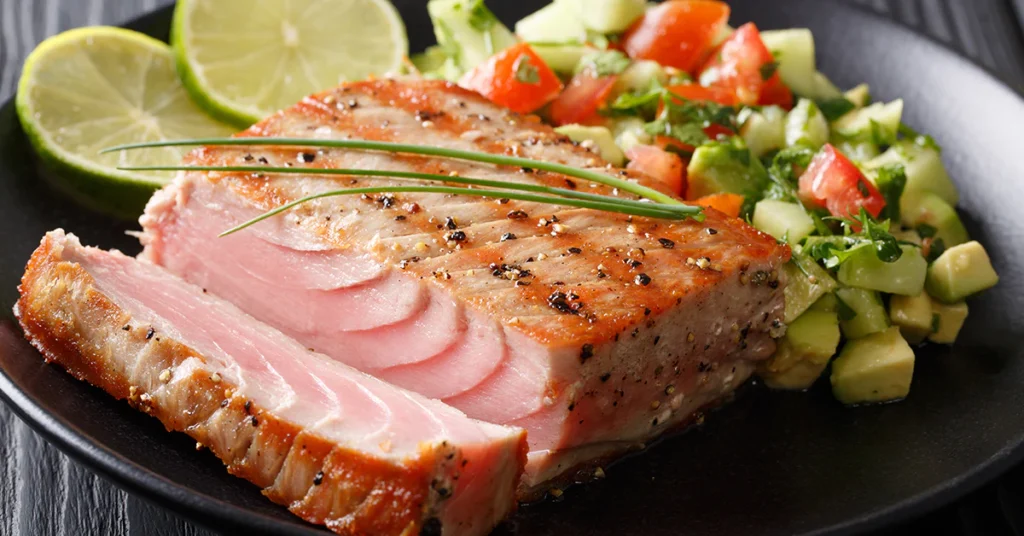

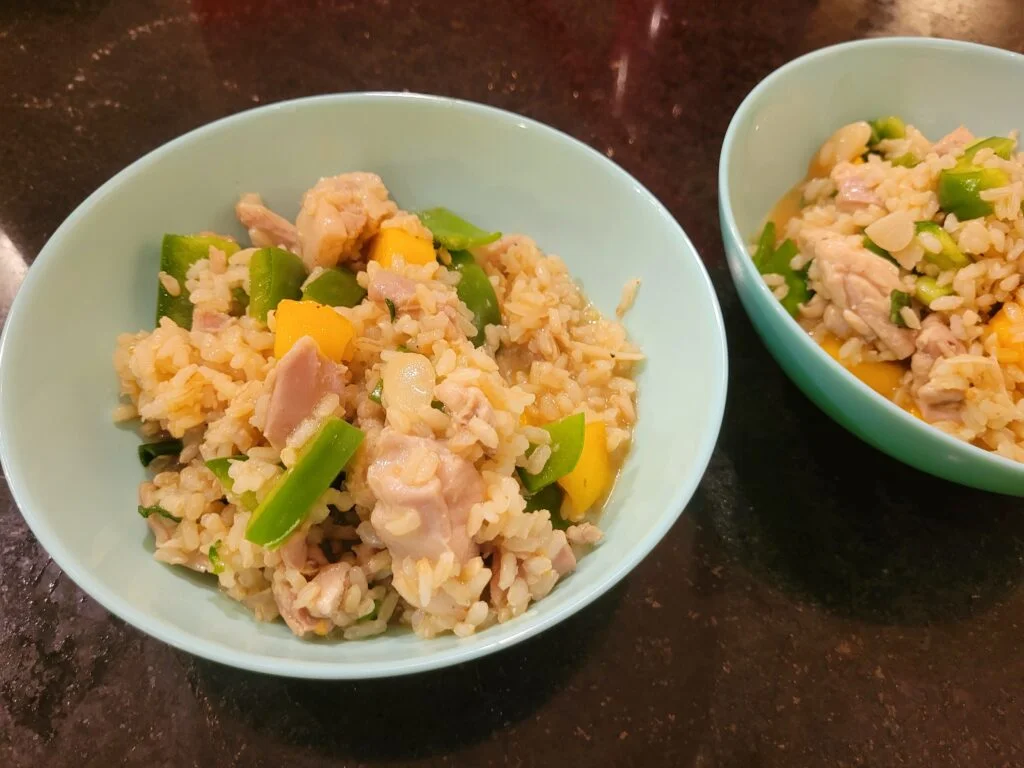
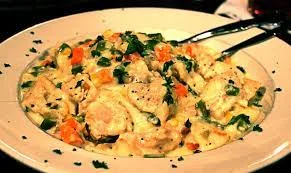
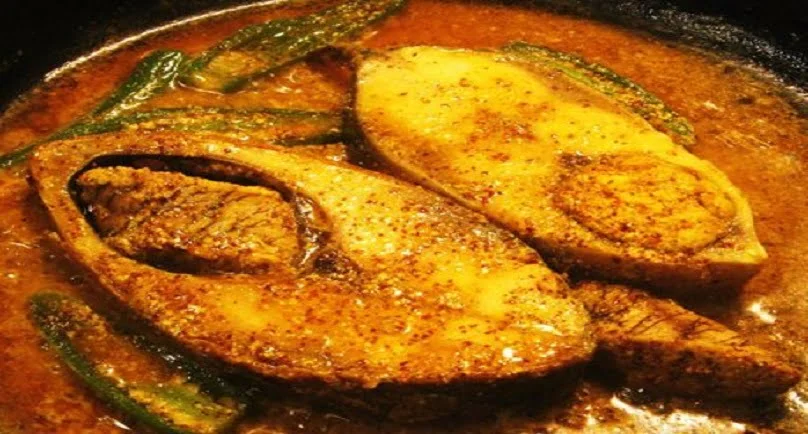
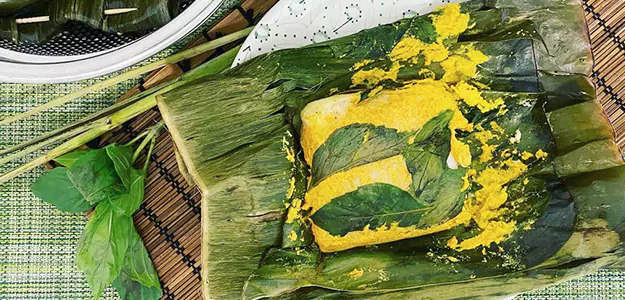
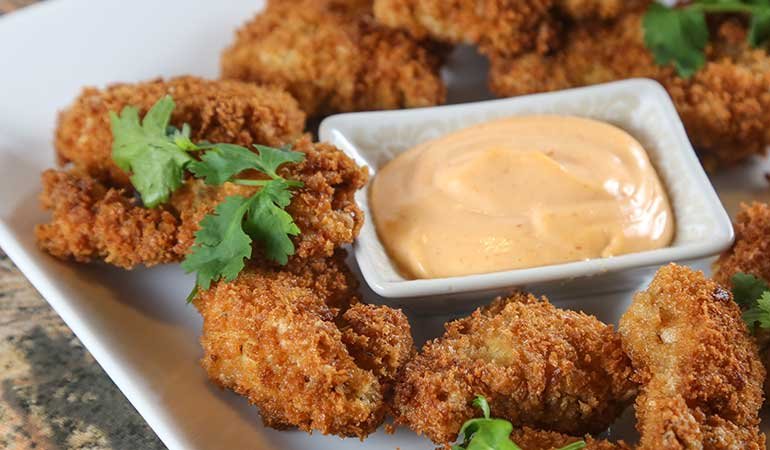
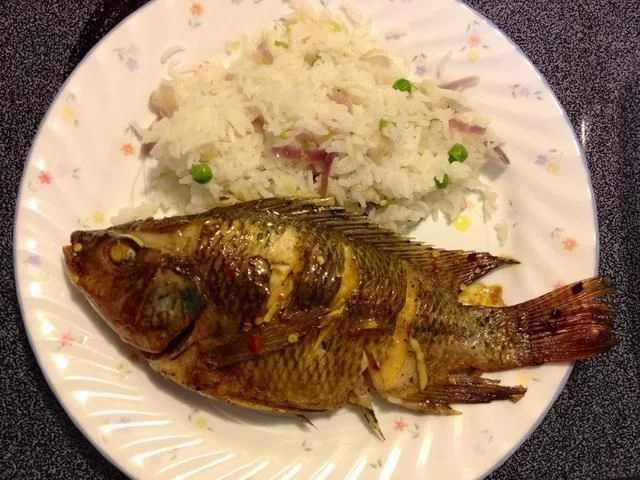
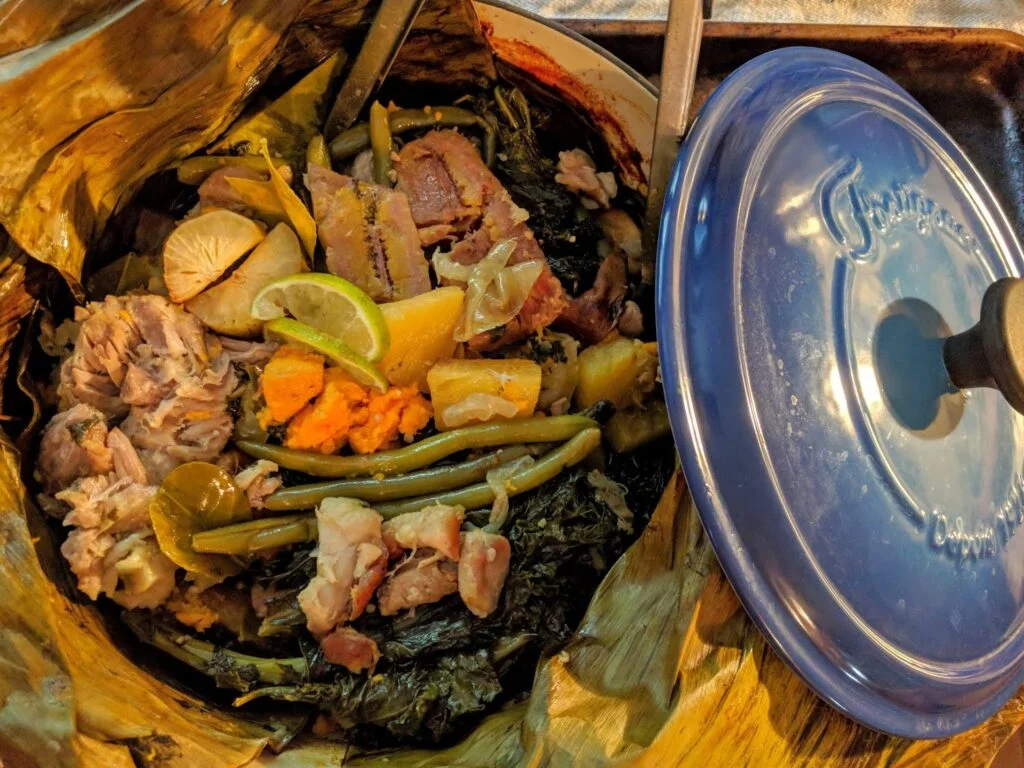
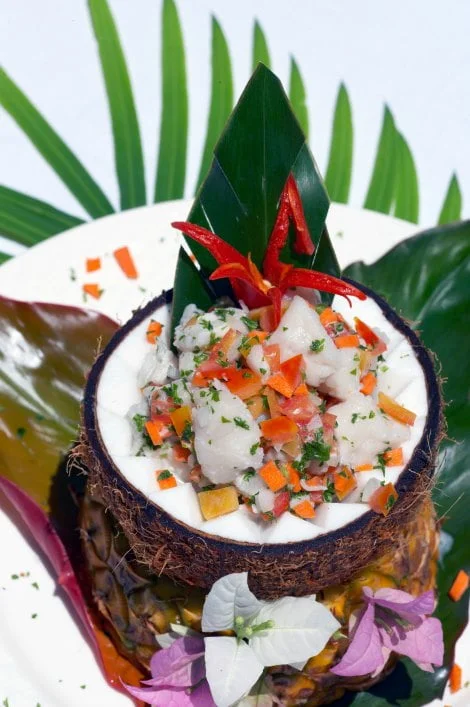
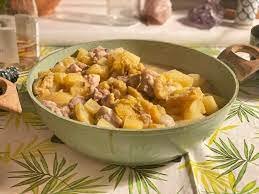
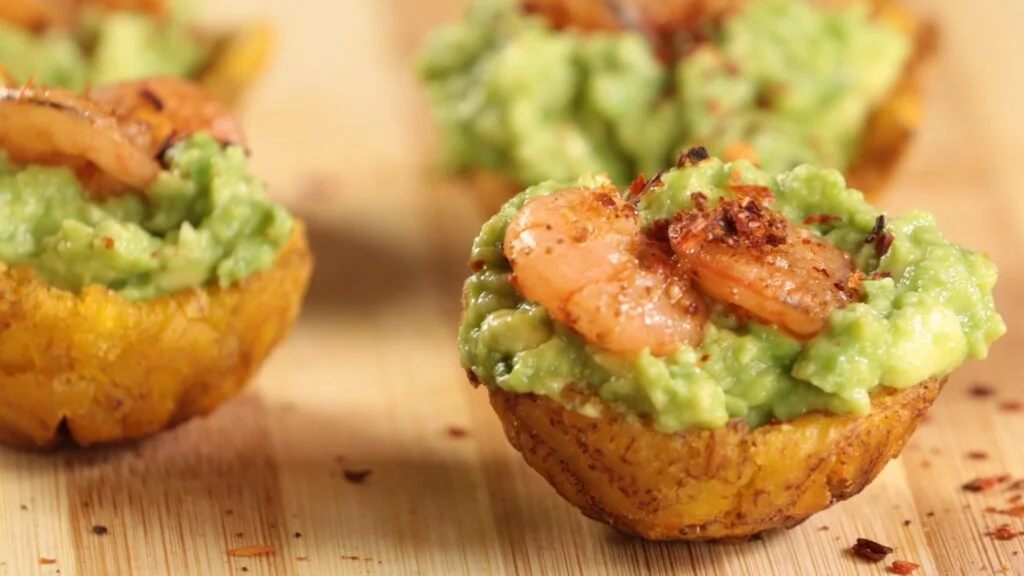
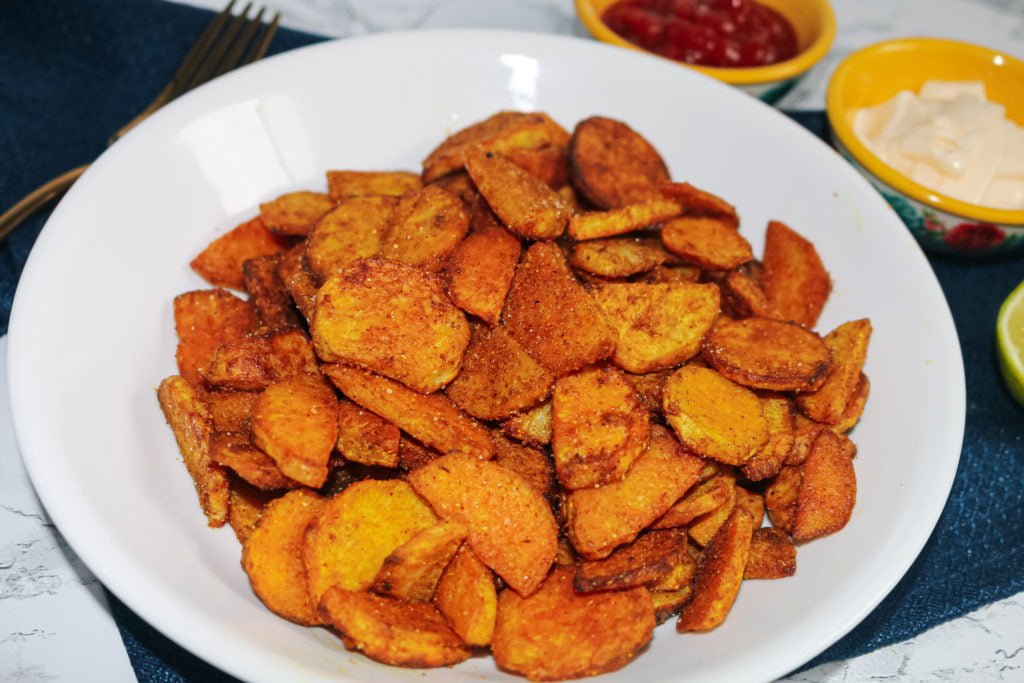
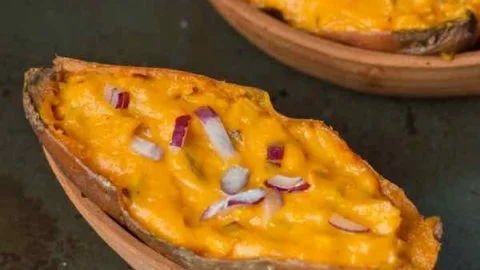
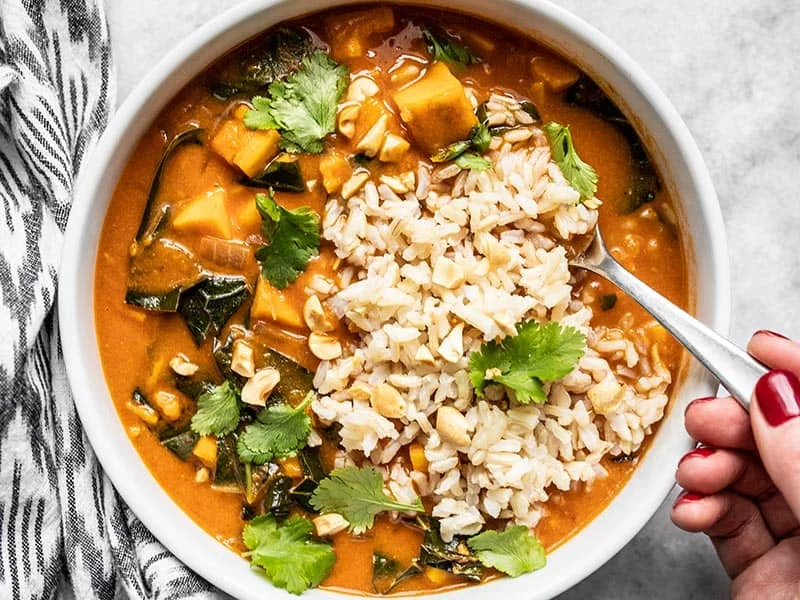
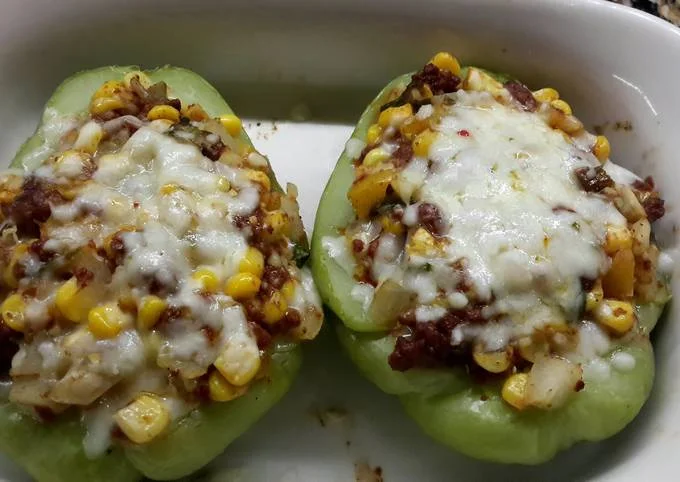
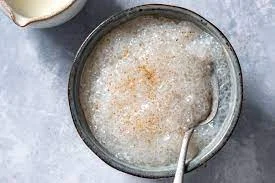
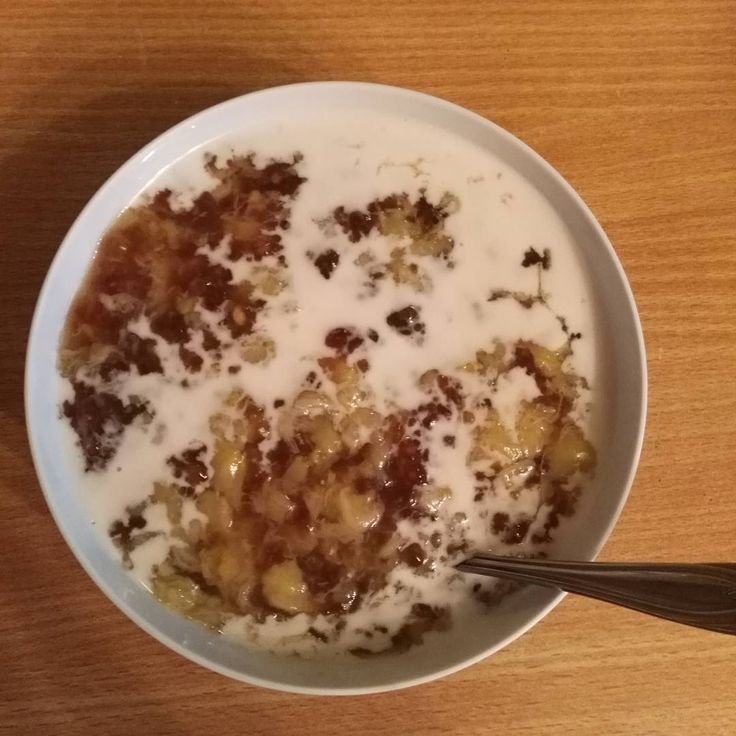
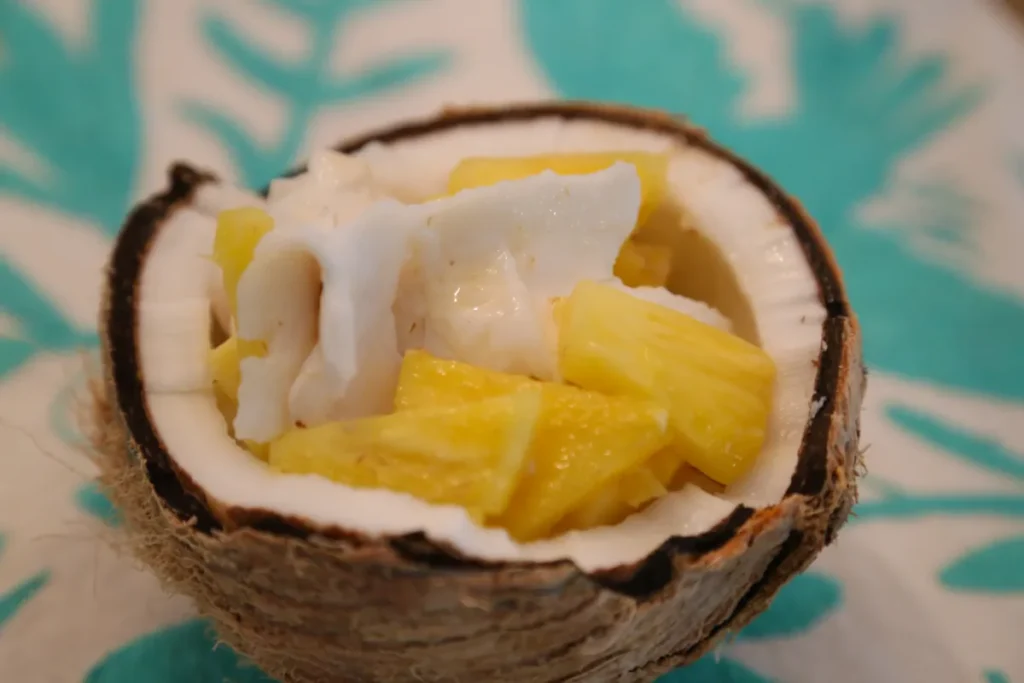
Papua New Guinea Food History
The country has a diverse and rich history, culture, and cuisine that reflects its many ethnic groups and geographic regions.
Papua New Guinea History

The history of Papua New Guinea can be traced back to about 50,000–60,000 years ago, when the first humans migrated to the island from Southeast Asia. European explorers first caught site of the islands in the early 17th century, and was later colonized by the British, the Germans, and the Australians.
Papua New Guinea gained its independence in 1975, after a long struggle against colonial rule and a civil war in Bougainville.
The Effect of History on Papua New Guinea’s Cuisine
Its history, geography, and environment influence the cuisine of Papua New Guinea . The staple foods are root crops, such as sweet potato (kaukau), cassava, taro, and sago.
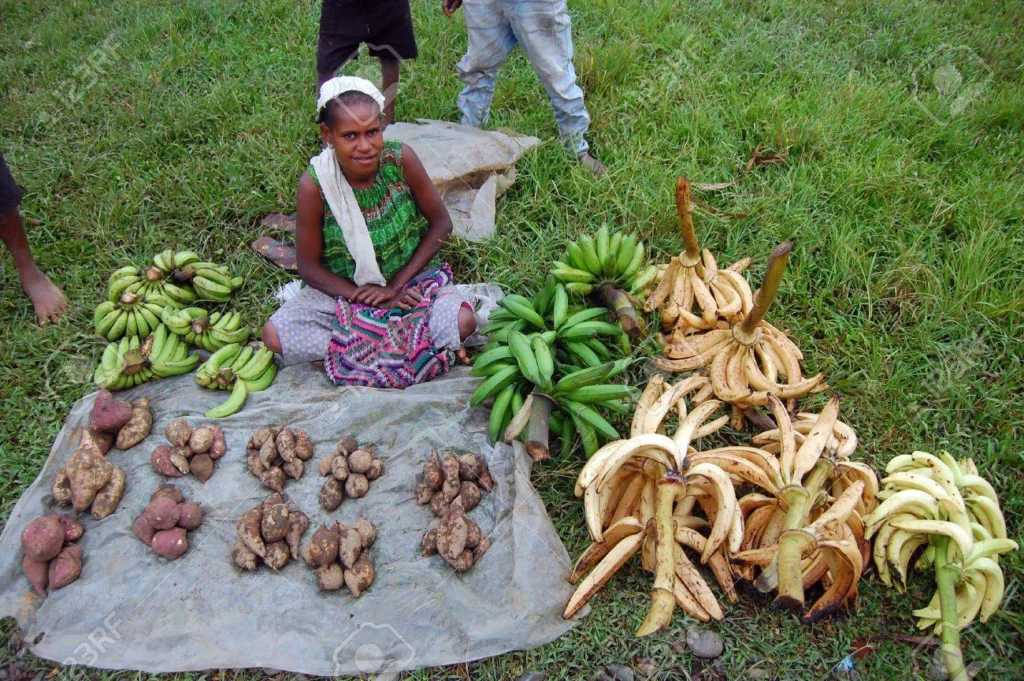
Bananas, coconuts, breadfruit, and karuka are also important sources of food
The coastal regions of Papua New Guinea have access to seafood, such as fish, shellfish, and seaweed, which provide protein and minerals. Coconut milk and cream are used as cooking mediums and flavor enhancers.
The highlands regions have less variety of seafood, but more meat, such as pork, chicken, and wild game. Pork is considered a delicacy and a symbol of status, and is often prepared in a traditional earth oven called mumu, along with vegetables and rice
The cuisine of Papua New Guinea also reflects the influence of foreign cultures, such as the Chinese, the Malays, the Indians, and the Europeans. Some dishes that have been adopted or adapted from these cultures include noodles, curry, rice, bread, and canned foods.
Spices, herbs, and condiments, such as ginger, garlic, chili, vinegar, and soy sauce, are also used to add flavor and variety to the dishes.
The cuisine of Papua New Guinea is a unique and fascinating aspect of its culture and history. It showcases the diversity and creativity of its people, as well as their adaptation and resilience to their environment and circumstances.
References
How Papua New Guinea’s Climate and Geography has influenced Papua New Guinean Cuisine
Papua New Guinea’s climate and geography have influenced its cuisine in various ways. Here are some examples:
Papua New Guinea’ Climate

The country has a tropical climate, with high temperatures and humidity throughout the year. This means that food preservation is difficult, and people tend to consume fresh or cooked food rather than stored or processed food
Papua New Guinea is Exposed to Natural Disasters


The country is also prone to natural disasters, such as volcanic eruptions, earthquakes, tsunamis, landslides, and floods, which can affect food security and availability. People have to adapt to these challenges by using local and seasonal ingredients, diversifying their food sources, and developing coping strategies.
Papua New Guinea has a Mixed Geography

The country has a diverse geography, with mountains, valleys, rivers, lakes, islands, and coasts. This creates different ecological zones and microclimates, which support a variety of flora and fauna.
People have access to different types of food depending on their location and elevation, such as root crops, fruits, nuts, vegetables, grains, fish, shellfish, seaweed, meat, and game.
The country’s geography also influences the methods of food preparation and cooking. For example, in the coastal regions, people use coconut milk and cream as cooking mediums and flavor enhancers, while in the highlands, people use a traditional earth oven called mumu to cook pork and vegetables.
Papua New Guinea’s cuisine is a reflection of its climate and geography, as well as its history, culture, and identity. It showcases the diversity and creativity of its people, as well as their adaptation and resilience to their environment and circumstances.
References
Understanding the Essence of Papua New Guinean Cuisine
To truly understand the essence of Papua New Guinean cuisine, one must consider the significance of the communal feast and the use of natural, locally sourced ingredients. Food is more than nourishment; it is a reason for gathering, a cause for celebration, and an expression of cultural identity.
The cuisine is characterized by the simplicity of its preparation and the freshness of its components, reflecting the people’s relationship with the land and sea.
Papua New Guinea Food Culture
Papua New Guinea food culture is a fascinating aspect of its history, culture, and identity. It showcases the diversity and creativity of its people, as well as their adaptation and resilience to their environment and circumstances. Here are some key points about Papua New Guinea food culture:
Papua New Guinea’s Cuisine is influenced by its history, geography, and environment.
The cuisine of Papua New Guinea is influenced by its history, geography, and environment. The country has a diverse and rich history, with many ethnic groups and colonial influences. The country also has a varied geography, with different ecological zones and microclimates, which support a variety of flora and fauna.
The country’s environment is tropical, with high temperatures and humidity, and prone to natural disasters, which affect food security and availability.
Papua New Guinea Cuisine used root Crops

The staple foods in Papua New Guinea include root crops, such as sweet potato (kaukau), cassava, taro, and sago, which are grown locally and provide carbohydrates and energy. Bananas, coconuts, breadfruit, and karuka are also important sources of food.
The country’s diet is mainly vegetarian, especially in the Gulf and Highlands regions. Meat proteins are rarely consumed, except for pork, which is considered a delicacy and a symbol of status. Seafood is more common in the coastal regions, where fish, shellfish, and seaweed are available.
Papua New Guinea Cuisine is Influenced by Foreign Cultures
The cuisine of Papua New Guinea also reflects the influence of foreign cultures, such as the Chinese, the Malays, the Indians, and the Europeans. Some dishes that have been adopted or adapted from these cultures include noodles, curry, rice, bread, and canned foods.
Spices, herbs, and condiments, such as ginger, garlic, chili, vinegar, and soy sauce, are also used to add flavor and variety to the dishes.
Popular Cooking Methods in Papua New Guinea
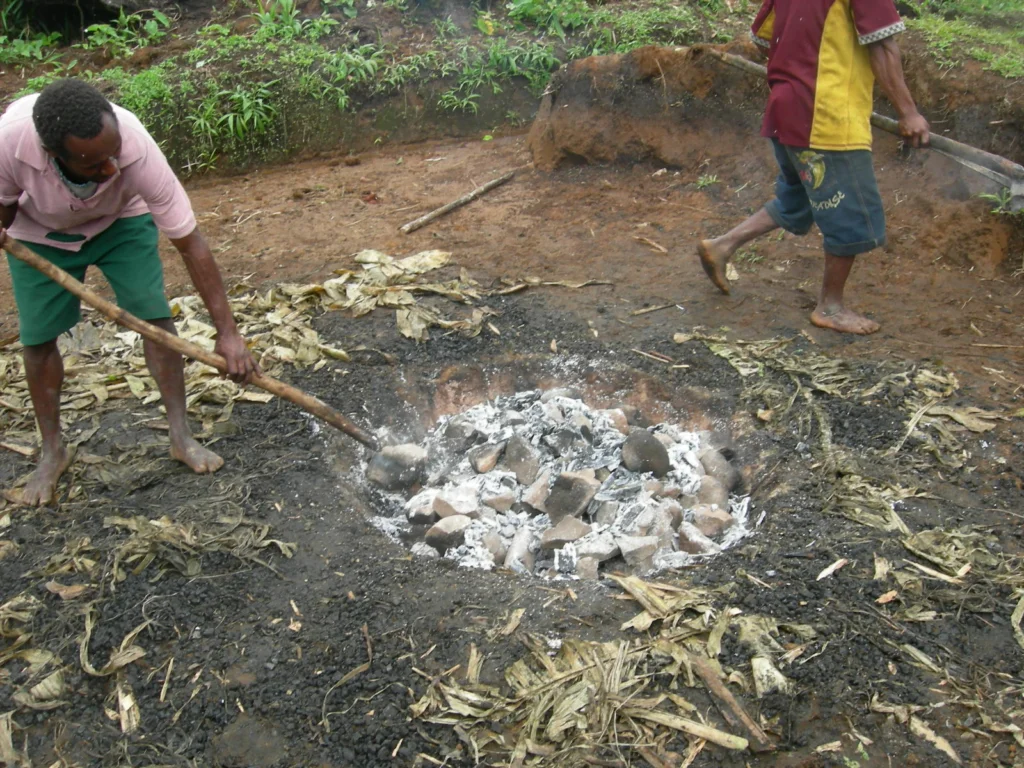
The most traditional and popular method of cooking in Papua New Guinea is the mumu, which is an earth oven that is filled with hot coal or stones, and then covered with banana leaves.
The mumu is used to cook large quantities of food, such as pork, sweet potato, rice, and vegetables, for special occasions, such as weddings, funerals, and festivals. The mumu is regarded as the national dish of Papua New Guinea, and is a symbol of communal sharing and celebration.
Papua New Guinea food culture is a unique and fascinating aspect of its culture and history. It showcases the diversity and creativity of its people, as well as their adaptation and resilience to their environment and circumstances.
Traditional Papua New Guinea Food

Traditional Papua New Guinea food is a vibrant reflection of the country’s diverse cultural landscape and rich natural resources. Staple ingredients like yams, sweet potatoes, taro, and sago are central to many dishes, providing a hearty base for various preparations.
The traditional cooking methods, often done in earth ovens called “mumu,” involve wrapping food in banana leaves and slow cooking it over hot stones. Fish, both fresh and saltwater varieties, is a significant protein source, complemented by an array of tropical fruits like bananas, coconuts, and pawpaw’s. Sago, derived from the pith of certain palm trees, is a crucial carbohydrate source.
This culinary tapestry not only sustains the people of Papua New Guinea but also serves as a cultural bridge, connecting generations through the shared experience of traditional food preparation and communal dining.
Exploring Papua New Guinea’s Ingredients: The Flavors of Papua New Guinean Cuisine
The flavors of Papua New Guinean cuisine are as diverse as its cultural mosaic. Ingredients such as taro, yams, bananas, and sago form the backbone of the diet. The abundant tropical fruit like papaya, pineapple, and mango add a natural sweetness to meals, while coconut is used both as a dairy substitute and for its oil.

The surrounding seas and rivers are sources of fresh fish and prawns, and the tradition of pig farming provides a source of protein, all combining to create a cuisine that is fresh, natural, and vibrant.
Papua New Guinea Food Easy Recipes
Papua New Guinean cuisine is an exciting gastronomical journey for any food lover.
It’s characterized by the use of fresh vegetables, tropical fruits, a variety of leafy greens, and proteins like pork and fish, cooked with methods that maximize natural flavors and nutritional value.
Papua New Guinea Food Mumu

The ‘mumu’ is not only a cooking method but also a dish in itself. It often features as a starter in communal feasts, showcasing a mix of sweet potatoes, bananas, and sometimes pork, all steamed together in the traditional earth oven.
Papua New Guinea Cuisine – Ingredients for Mumu
- Sweet potatoes, peeled and chopped
- Green bananas, peeled
- Pork pieces, traditionally with fat on for flavor
- Salt and pepper to taste
- Banana leaves for wrapping
Papua New Guinea Cuisine – How to prepare Mumu
Wrap the ingredients in banana leaves and place them in a pit over hot stones. Cover with more banana leaves, then earth, and slow cook for several hours.
To present, unwrap the banana leaves at the table to reveal the steamed contents, releasing the fragrant aroma.
Serve with a side of sago or rice, and a fresh, tangy salad to cut through the richness of the pork.
A cool, crisp lager would complement the smoky flavors of the mumu perfectly.
Papua New Guinea Cuisine – Kokoda
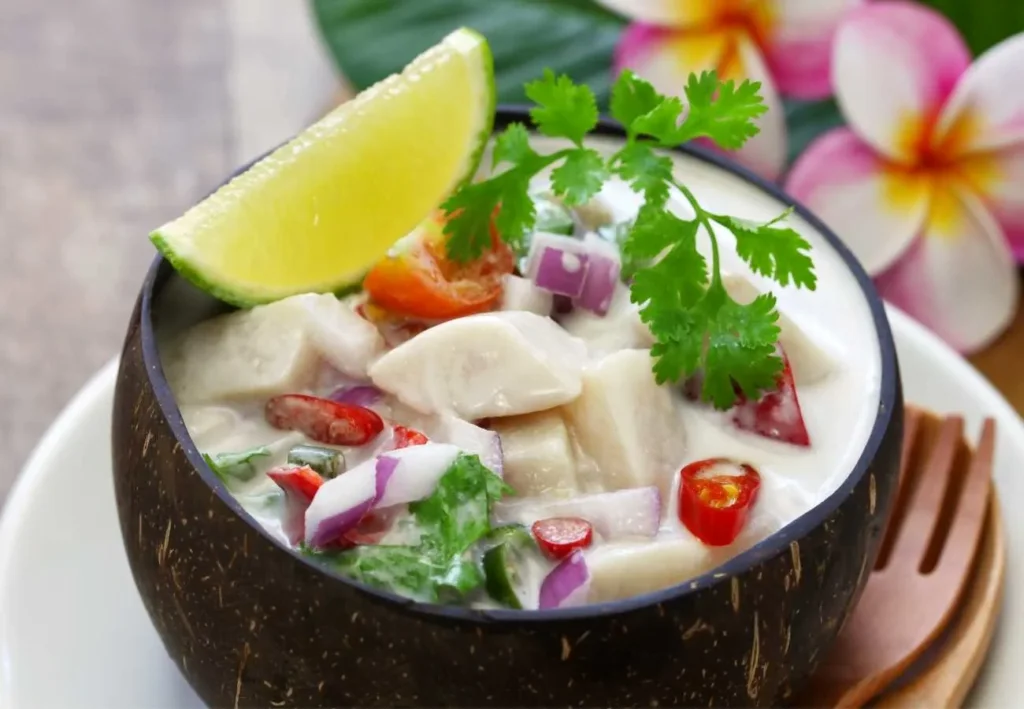
Kokoda is Papua New Guinea’s answer to ceviche, typically made with fresh fish marinated in lime juice and coconut milk.
Papua New Guinea Cuisine – Ingredients for Kokoda
- Fresh white fish fillets, diced
- Lime juice, enough to cover the fish
- Coconut milk
- Diced tomatoes
- Finely chopped chili (optional)
- Chopped coriander
- Salt to taste
Papua New Guinea Cuisine – How to prepare Kokoda
Marinate the diced fish in lime juice for several hours until the flesh becomes opaque. Drain and mix with coconut milk, tomatoes, chili, and coriander. Season with salt to taste.
Serve in small bowls or coconut shells, garnished with extra coriander.
Pair with a light white wine, like a Sauvignon Blanc, that won’t overpower the delicate flavors of the fish.
Papua New Guinea Cuisine – Chicken Pot

Papua New Guinea Cuisine – Ingredients
- Whole chicken, cut into pieces
- Coconut milk
- Garlic, minced
- Ginger, grated
- Lemongrass, bruised
- Chili, sliced (optional)
- Salt and pepper to taste
How to prepare
Brown the chicken with garlic and ginger, then simmer in coconut milk with lemongrass and chili until tender.
Serve over steamed rice or with a side of boiled sweet potatoes.
A full-bodied Chardonnay pairs beautifully with the creamy coconut flavors.
Papua New Guinea Cuisine – Pork and Sweet Potato Stew

Papua New Guinea Cuisine – Ingredients for Pork and Sweet Potato Stew
- Pork shoulder, cubed
- Sweet potatoes, peeled and cubed
- Onions, sliced
- Garlic, minced
- Chicken or vegetable stock
- Green beans or other available vegetables
- Salt and pepper to taste
Papua New Guinea Cuisine – How to prepare Pork and Sweet Potato Stew
Brown the pork with onions and garlic, add sweet potatoes and stock, and simmer until the pork is tender and sweet potatoes are soft. Stir in green beans towards the end of cooking.
Present in a deep dish, garnished with fresh herbs.
Serve with a robust red wine, like a Syrah, that can stand up to the bold flavors of the stew.
Papua New Guinea Food – Sweet Potato Mashed with Coconut Milk

History and Background:
Sweet Potato Mashed with Coconut Milk is a traditional and beloved dish in Papua New Guinea, reflecting the rich agricultural landscape and cultural significance of sweet potatoes in the region. Sweet potatoes have been a staple in Papua New Guinean cuisine for centuries, offering a versatile and nutritious base for various recipes.
This dish, often prepared during communal gatherings and celebrations, showcases the harmonious blend of locally grown sweet potatoes and the creamy richness of coconut milk, creating a flavorsome and comforting side dish.
Papua New Guinea Food – Sweet Potato Mashed with Coconut Milk Ingredients:
- For the Mashed Sweet Potatoes:
- 4 large sweet potatoes, peeled and diced
- 1 cup coconut milk
- 2 tablespoons unsalted butter
- Salt to taste
- For Garnish:
- Fresh cilantro or parsley, chopped (optional)
Papua New Guinea Food – Sweet Potato Mashed with Coconut Milk Recipe:
1. Cooking the Sweet Potatoes:
- Ingredients:
- 4 large sweet potatoes, peeled and diced
- Steps:
- Place the diced sweet potatoes in a large pot and cover them with water.
- Bring the water to a boil and cook the sweet potatoes until they are fork-tender.
2. Mashing the Sweet Potatoes:
- Ingredients:
- Cooked sweet potatoes
- 1 cup coconut milk
- 2 tablespoons unsalted butter
- Salt to taste
- Steps:
- Drain the cooked sweet potatoes and return them to the pot.
- Mash the sweet potatoes using a potato masher or fork.
- Gradually add coconut milk and unsalted butter while continuing to mash.
- Season the mixture with salt to taste and continue mashing until smooth.
3. Serving and Garnishing:
- Ingredients:
- Fresh cilantro or parsley, chopped (optional)
- Steps:
- Transfer the Sweet Potato Mash to a serving dish.
- Garnish with freshly chopped cilantro or parsley if desired.
Serving:
- This recipe serves 4 people.
Cooking Time:
- Approximately 20-25 minutes.
Estimated Calories:
- The total calories for this recipe are approximately 600 calories.
Papua New Guinea Recipes – Savory Roasted Taro

History and Background of Papua New Guinea Savory Roasted Taro
Papua New Guinea, a country known for its rich cultural diversity, offers a delightful culinary experience with dishes like Savory Roasted Taro. Taro, a starchy root vegetable, has been a staple in the diet of Papua New Guineans for centuries.
This traditional dish reflects the indigenous connection to the land and showcases the simplicity and flavors of Papua New Guinean cuisine.
Ingredients for Papua New Guinea Savory Roasted Taro
- 2 large taro roots, peeled and sliced into 1-inch cubes
- 3 tablespoons olive oil
- 1 teaspoon salt
- 1 teaspoon black pepper
- 1 teaspoon paprika
- 1 teaspoon garlic powder
- 1 teaspoon onion powder
- Fresh parsley for garnish (optional)
Estimated Cooking Time: 40 minutes
Servings: 4
Recipe for Papua New Guinea Savory Roasted Taro
1. Prepare the Taro
- Preheat the oven to 400°F (200°C).
- Peel the taro roots and cut them into 1-inch cubes.
2. Season the Taro
- In a large bowl, combine the taro cubes with olive oil, salt, black pepper, paprika, garlic powder, and onion powder.
- Toss the taro cubes until evenly coated with the seasoning.
3. Roast the Taro
- Spread the seasoned taro cubes in a single layer on a baking sheet.
- Roast in the preheated oven for 25-30 minutes or until the taro is golden brown and crispy on the edges.
4. Garnish and Serve
- Remove the roasted taro from the oven and let it cool for a few minutes.
- Garnish with fresh parsley if desired.
- Serve the Savory Roasted Taro as a delightful side dish or snack.
Calories per Serving: Approximately 180 calories
This Papua New Guinea Savory Roasted Taro recipe captures the essence of the region’s cuisine, offering a delicious and nutritious way to enjoy this versatile root vegetable. The simplicity of the preparation allows the natural flavors of taro to shine through, providing a delightful accompaniment to any meal.
Papua New Guinea Recipes – Plantain Basket with Avocado and Shrimp

History and Background:
Plantain Basket with Avocado and Shrimp is a delightful dish originating from the diverse and vibrant culinary landscape of Papua New Guinea. Rooted in the region’s abundant tropical produce, this recipe showcases the creative use of plantains, avocados, and shrimp—ingredients readily available in the area.
The dish not only reflects the richness of Papua New Guinean flavors but also emphasizes the cultural importance of communal eating and the celebration of fresh, locally sourced ingredients.
Papua New Guinea Recipes – Plantain Basket with Avocado and Shrimp Ingredients:
- Plantain Basket:
- 4 ripe plantains
- 2 tablespoons vegetable oil
- Salt to taste
- Avocado and Shrimp Filling:
- 1 ripe avocado, diced
- 1 cup cooked shrimp, peeled and deveined
- 1/2 red onion, finely chopped
- 1 tomato, diced
- Fresh cilantro, chopped
- Juice of 1 lime
- Salt and pepper to taste
Papua New Guinea Recipes – Plantain Basket with Avocado and Shrimp Recipe:
1. Preparing the Plantain Baskets:
- Ingredients:
- 4 ripe plantains
- 2 tablespoons vegetable oil
- Salt to taste
- Steps:
- Peel the plantains and cut them into thin, lengthwise strips.
- In a pan, heat vegetable oil over medium heat.
- Arrange the plantain strips to form small baskets, ensuring they stick together.
- Fry the plantain baskets until golden brown on both sides.
- Remove from the pan, place on paper towels to drain excess oil, and sprinkle with salt.
2. Creating the Avocado and Shrimp Filling:
- Ingredients:
- 1 ripe avocado, diced
- 1 cup cooked shrimp, peeled and deveined
- 1/2 red onion, finely chopped
- 1 tomato, diced
- Fresh cilantro, chopped
- Juice of 1 lime
- Salt and pepper to taste
- Steps:
- In a bowl, combine diced avocado, cooked shrimp, chopped red onion, diced tomato, and fresh cilantro.
- Squeeze the juice of one lime over the mixture and toss gently.
- Season with salt and pepper to taste.
3. Assembling the Plantain Baskets:
- Ingredients:
- Prepared plantain baskets
- Avocado and shrimp filling
- Steps:
- Carefully spoon the avocado and shrimp filling into the plantain baskets.
- Garnish with additional cilantro if desired.
Serving:
- This recipe serves 4 people.
Estimated Cooking Time:
- Approximately 30-40 minutes.
Estimated Calories:
- The total calories for this recipe are approximately 1200 calories.
Papua New Guinea Recipes – Fried Gator

Papua New Guinea Recipes – Fried Gator
One of the traditional dishes of Papua New Guinea is fried gator, which is made from alligator meat. Alligators are found in the swamps and rivers of the southern and western parts of the country and are hunted for their meat and skin.
Alligator meat is considered a delicacy and a source of protein and is usually fried with spices and herbs.
Fried gator is a simple and tasty dish that can be served with rice, bread, or vegetables. It is a popular dish for special occasions, such as festivals, weddings, and feasts. Here is how you can make fried gator at home.
Papua New Guinea Recipes – Fried Gator Ingredients
- 1 kg of alligator meat, cut into bite-sized pieces
- 2 tablespoons of vegetable oil
- 1 onion, chopped
- 4 cloves of garlic, minced
- 2 teaspoons of salt
- 1 teaspoon of black pepper
- 1 teaspoon of paprika
- 1/4 teaspoon of cayenne pepper
- 2 tablespoons of lemon juice
- 2 tablespoons of chopped parsley
Papua New Guinea Recipes – Fried Gator Recipe
- Heat the oil in a large skillet over medium-high heat. Add the onion and garlic and cook until soft, stirring occasionally, for about 15 minutes.
- Add the salt, black pepper, paprika, and cayenne pepper and stir well. Add the alligator meat and toss to coat with the spices. Cook for about 20 minutes, turning occasionally, until the meat is browned and cooked through.
- Sprinkle the lemon juice and parsley over the meat and stir to combine. Serve hot with your choice of side dish.
This recipe serves 4 people.
The estimated cooking time is 45 minutes.
The total calories of the ingredients are 1,720 kcal.
Papua New Guinea Recipes – Curried fish

History and Background of Papua New Guinea Curried Fish
Papua New Guinea, a vibrant island nation in the southwestern Pacific, boasts a rich culinary heritage shaped by diverse indigenous cultures. The traditional cuisine of Papua New Guinea often features fresh seafood, reflecting the abundance of marine life in its coastal regions.
One standout dish is Curried Fish, a flavorful and aromatic delicacy that showcases the fusion of local ingredients and spices, creating a unique culinary experience.
Ingredients for Papua New Guinea Curried Fish
- 1.5 lbs fresh fish fillets (snapper or grouper work well)
- 2 tablespoons curry powder
- 1 onion, finely chopped
- 2 cloves garlic, minced
- 1 thumb-sized piece of ginger, grated
- 1 can (14 oz) coconut milk
- 2 tablespoons cooking oil
- 1 tablespoon tomato paste
- 1 tablespoon fish sauce
- 1 tablespoon soy sauce
- 1 tablespoon lime juice
- Salt and pepper to taste
- Fresh cilantro leaves for garnish
Estimated Cooking Time: 45 minutes
Servings: 4
Recipe for Papua New Guinea Curried Fish
1. Prepare the Ingredients
- Rinse the fish fillets under cold water and pat them dry with paper towels.
- Chop the onion, mince the garlic, and grate the ginger.
- In a small bowl, mix the curry powder with a bit of water to form a smooth paste.
2. Cook the Curry Base
- Heat the cooking oil in a large skillet over medium heat.
- Add the chopped onion, minced garlic, and grated ginger. Sauté until the onion is translucent.
- Stir in the curry paste and cook for an additional 2 minutes.
3. Add the Fish
- Place the fish fillets into the skillet, ensuring they are coated with the curry mixture.
- Pour in the coconut milk, then add the tomato paste, fish sauce, soy sauce, and lime juice.
- Season with salt and pepper to taste.
4. Simmer and Serve
- Bring the mixture to a gentle simmer and cover the skillet. Allow the fish to cook for about 20-25 minutes or until it flakes easily with a fork.
- Garnish with fresh cilantro leaves before serving.
Calories per Serving: Approximately 380 calories
This Papua New Guinea Curried Fish recipe offers a delightful combination of flavors, showcasing the culinary traditions of this unique Pacific island nation. Enjoy this dish with steamed rice or traditional root vegetables for a complete and satisfying meal.
Papua New Guinea Recipes – Vegetable-Stuffed Chayote

History and Background of Papua New Guinea Vegetable-Stuffed Chayote
Papua New Guinea, a nation known for its diverse landscapes and vibrant cultures, showcases its culinary richness through dishes like Vegetable-Stuffed Chayote. This traditional recipe highlights the creativity and resourcefulness of Papua New Guinean cooking, incorporating locally grown produce to create a flavorful and nutritious dish.
Chayote, a versatile vegetable, takes center stage in this recipe, reflecting the region’s commitment to sustainable and wholesome ingredients.
Ingredients for Papua New Guinea Vegetable-Stuffed Chayote
- 4 chayote squash, halved and pitted
- 1 cup mixed vegetables (carrots, peas, corn, etc.), finely chopped
- 1 onion, finely chopped
- 2 cloves garlic, minced
- 1 tomato, diced
- 1/2 cup cooked rice
- 2 tablespoons cooking oil
- 1 teaspoon curry powder
- 1 teaspoon dried thyme
- Salt and pepper to taste
- Grated cheese for topping (optional)
Estimated Cooking Time: 50 minutes
Servings: 4
Recipe for Papua New Guinea Vegetable-Stuffed Chayote
1. Prepare the Chayote
- Preheat the oven to 375°F (190°C).
- Cut the chayote squash in half, and scoop out the seeds to create a hollow center.
2. Cook the Filling
- In a pan, heat the cooking oil over medium heat.
- Add chopped onions and minced garlic, sautéing until the onions are translucent.
- Stir in the mixed vegetables, diced tomato, and cook until the vegetables are tender.
- Add curry powder, dried thyme, salt, and pepper, mixing well.
- Finally, fold in the cooked rice and combine thoroughly.
3. Stuff the Chayote
- Spoon the vegetable and rice mixture into the hollowed centers of the chayote halves.
- Place the stuffed chayote in a baking dish, cover with foil, and bake in the preheated oven for 30-35 minutes or until the chayote is fork-tender.
4. Garnish and Serve
- Optionally, top each stuffed chayote with grated cheese during the last 5 minutes of baking.
- Remove from the oven, garnish with fresh herbs if desired, and serve warm.
Calories per Serving: Approximately 220 calories
Papua New Guinea Vegetable-Stuffed Chayote brings together the goodness of local produce and culinary creativity. This nutritious and flavorful dish celebrates the region’s commitment to using wholesome ingredients, making it a delightful addition to any Papua New Guinean meal.
Papua New Guinea Recipes – Baked Chayote Squash

History and Background of Papua New Guinea Baked Chayote Squash
Papua New Guinea, with its lush landscapes and diverse cultures, introduces the culinary gem of Baked Chayote Squash. Rooted in the region’s agricultural abundance, this dish exemplifies the resourcefulness of Papua New Guinean cuisine.
Chayote squash, a versatile and locally grown vegetable, takes center stage in this recipe, showcasing the simplicity and richness of flavors that define the region’s culinary heritage.
Ingredients for Papua New Guinea Baked Chayote Squash
- 4 chayote squash, peeled and sliced
- 2 tablespoons olive oil
- 1 teaspoon garlic powder
- 1 teaspoon onion powder
- 1 teaspoon dried thyme
- Salt and pepper to taste
- 1/2 cup grated Parmesan cheese
- Fresh parsley for garnish (optional)
Estimated Cooking Time: 35 minutes
Servings: 4
Recipe for Papua New Guinea Baked Chayote Squash
1. Prepare the Chayote Squash
- Preheat the oven to 400°F (200°C).
- Peel the chayote squash and slice them into uniform pieces.
2. Season the Chayote Squash
- In a large bowl, toss the chayote slices with olive oil, ensuring they are evenly coated.
- Sprinkle garlic powder, onion powder, dried thyme, salt, and pepper over the chayote slices, mixing well.
3. Bake the Chayote Squash
- Arrange the seasoned chayote slices in a single layer on a baking sheet.
- Bake in the preheated oven for 20-25 minutes or until the chayote is tender and edges are golden brown.
4. Garnish and Serve
- Remove the baked chayote from the oven and sprinkle grated Parmesan cheese over the top.
- Optionally, garnish with fresh parsley for added flavor and visual appeal.
- Serve the Baked Chayote Squash as a delightful side dish to complement your meal.
Calories per Serving: Approximately 110 calories
Papua New Guinea Baked Chayote Squash is a testament to the region’s culinary ingenuity, highlighting the natural goodness of locally sourced ingredients. This simple and savory dish adds a burst of flavor to any meal, embodying the essence of Papua New Guinean cuisine.
Papua New Guinea Recipes – Chicken and mango rice

History and Background of Papua New Guinea Chicken and Mango Rice
In the heart of Papua New Guinea, where diverse cultures thrive amidst stunning landscapes, the culinary tapestry is woven with unique flavors. Chicken and Mango Rice, a beloved dish, encapsulates the essence of Papua New Guinean cuisine.
This recipe embodies the harmonious blend of locally sourced ingredients, celebrating the region’s agricultural richness and cultural diversity.
Ingredients for Papua New Guinea Chicken and Mango Rice
- 1.5 lbs chicken, cut into bite-sized pieces
- 2 cups jasmine rice, rinsed
- 2 ripe mangoes, peeled and diced
- 1 onion, finely chopped
- 2 cloves garlic, minced
- 1 red bell pepper, diced
- 1 cup green beans, chopped
- 1 tablespoon curry powder
- 1 teaspoon turmeric powder
- 1 teaspoon cumin
- 1 can (14 oz) coconut milk
- 2 tablespoons cooking oil
- Salt and pepper to taste
- Fresh cilantro for garnish (optional)
Estimated Cooking Time: 50 minutes
Servings: 6
Recipe for Papua New Guinea Chicken and Mango Rice
1. Prepare the Ingredients
- Rinse the jasmine rice thoroughly.
- Peel and dice the mangoes.
- Chop the onion, mince the garlic, dice the red bell pepper, and chop the green beans.
2. Cook the Chicken
- In a large skillet, heat cooking oil over medium heat.
- Add chopped onions and minced garlic, sautéing until fragrant.
- Add chicken pieces and cook until browned on all sides.
3. Add Vegetables and Spices
- Stir in diced mangoes, red bell pepper, and green beans.
- Add curry powder, turmeric, and cumin, mixing well.
- Season with salt and pepper to taste.
4. Cook the Rice
- Add rinsed jasmine rice to the skillet, stirring to combine with the chicken and vegetables.
- Pour in coconut milk and bring the mixture to a gentle simmer.
- Cover the skillet and let it cook for 20-25 minutes or until the rice is tender.
5. Garnish and Serve
- Fluff the rice with a fork, ensuring it’s evenly mixed.
- Optionally, garnish with fresh cilantro before serving.
Calories per Serving: Approximately 480 calories
Chicken and Mango Rice from Papua New Guinea offers a delicious medley of flavors, reflecting the country’s diverse culinary influences. This hearty and aromatic dish is perfect for sharing, embodying the warmth and hospitality of Papua New Guinean cuisine.
Papua New Guinea Recipes – Talautu

History and Background of Papua New Guinea Talautu
In the vibrant culinary tapestry of Papua New Guinea, the dish known as Talautu holds a special place. Originating from the region’s rich cultural diversity, Talautu reflects the traditional cooking practices and locally available ingredients.
This hearty and flavorful recipe embodies the spirit of Papua New Guinean hospitality, making it a cherished part of communal gatherings and celebrations.
Ingredients for Papua New Guinea Talautu
- 2 lbs pork belly, cut into bite-sized pieces
- 2 cups taro, peeled and diced
- 2 cups sweet potato, peeled and diced
- 2 cups cassava, peeled and diced
- 1 onion, finely chopped
- 3 cloves garlic, minced
- 2 tablespoons cooking oil
- 1 teaspoon ground turmeric
- 1 teaspoon paprika
- Salt and pepper to taste
- Fresh parsley for garnish (optional)
Estimated Cooking Time: 2 hours
Servings: 6
Recipe for Papua New Guinea Talautu
1. Prepare the Ingredients
- Cut pork belly into bite-sized pieces.
- Peel and dice taro, sweet potato, and cassava.
- Chop onion and mince garlic.
2. Sear the Pork
- In a large pot, heat cooking oil over medium heat.
- Add pork pieces and sear until browned on all sides.
3. Add Aromatics and Spices
- Add chopped onion and minced garlic to the pot, sautéing until softened.
- Sprinkle ground turmeric and paprika over the pork, stirring to coat evenly.
- Season with salt and pepper to taste.
4. Simmer the Ingredients
- Add diced taro, sweet potato, and cassava to the pot, stirring to combine.
- Pour enough water to cover the ingredients.
- Bring the mixture to a boil, then reduce heat to low and let it simmer for approximately 1.5 to 2 hours or until the pork is tender and the root vegetables are cooked through.
5. Garnish and Serve
- Check for seasoning and adjust as needed.
- Garnish with fresh parsley if desired.
- Serve the Talautu hot, allowing the flavors to meld together.
Calories per Serving: Approximately 450 calories
Talautu from Papua New Guinea is a soul-warming dish that brings people together over a shared appreciation for the country’s culinary heritage. Rooted in tradition and showcasing the abundance of local ingredients, Talautu is a delicious testament to the diverse flavors of Papua New Guinean cuisine.
Papua New Guinea Recipes – Baked Rainbow Trout

History and Background of Papua New Guinea Baked Rainbow Trout Yams and Greens
In the heart of Papua New Guinea, where lush landscapes meet diverse cultures, the dish of Baked Rainbow Trout with Yams and Greens emerges as a culinary delight. Drawing from the region’s rich natural resources, this recipe reflects the fusion of indigenous flavors and traditional cooking techniques.
The combination of rainbow trout, yams, and greens showcases the bounty of Papua New Guinean waters and fertile land, creating a wholesome and flavorful dish.
Ingredients for Papua New Guinea Baked Rainbow Trout Yams and Greens
- 4 rainbow trout fillets
- 2 large yams, peeled and sliced
- 4 cups mixed greens (spinach, kale, or collard greens)
- 1 lemon, sliced
- 4 tablespoons olive oil
- 2 cloves garlic, minced
- 1 teaspoon dried thyme
- Salt and pepper to taste
- Fresh parsley for garnish (optional)
Estimated Cooking Time: 35 minutes
Servings: 4
Recipe for Papua New Guinea Baked Rainbow Trout Yams and Greens
1. Prepare the Ingredients
- Preheat the oven to 375°F (190°C).
- Peel and slice the yams.
- Rinse and pat dry the rainbow trout fillets.
- Mix minced garlic with olive oil.
2. Season the Trout
- Place the rainbow trout fillets on a baking sheet.
- Drizzle half of the garlic-infused olive oil over the fillets.
- Sprinkle dried thyme, salt, and pepper on the trout.
- Lay lemon slices on top of the fillets.
3. Prepare the Yams and Greens
- In a bowl, toss the sliced yams with the remaining garlic-infused olive oil, salt, and pepper.
- Spread the yams around the rainbow trout on the baking sheet.
- Place the baking sheet in the preheated oven and bake for 20 minutes.
4. Add Greens and Finish Baking
- After 20 minutes, add mixed greens to the baking sheet around the yams and trout.
- Return the baking sheet to the oven and bake for an additional 10-15 minutes or until the trout flakes easily and the yams are tender.
5. Garnish and Serve
- Remove from the oven and garnish with fresh parsley if desired.
- Serve the Baked Rainbow Trout with Yams and Greens hot, allowing the vibrant flavors to shine.
Calories per Serving: Approximately 380 calories
This Papua New Guinea dish captures the essence of the region’s culinary artistry, blending fresh and local ingredients to create a wholesome and satisfying meal. The Baked Rainbow Trout with Yams and Greens is a celebration of Papua New Guinean flavors, harmonizing the bounty of land and sea in a single, delightful dish.
Papua New Guinea Recipes – Vegetable and peanut stew

History and Background of Papua New Guinea Vegetable and Peanut Stew
Embedded in the heart of Papua New Guinea’s culinary heritage, the Vegetable and Peanut Stew stands as a testament to the region’s rich agricultural diversity and vibrant flavors.
Rooted in indigenous traditions, this stew brings together a medley of locally grown vegetables and the nutty richness of peanuts, reflecting the resourcefulness and creativity ingrained in Papua New Guinean cooking.
Ingredients for Papua New Guinea Vegetable and Peanut Stew
- 1 cup peanuts, unsalted
- 2 tablespoons cooking oil
- 1 onion, finely chopped
- 2 cloves garlic, minced
- 2 sweet potatoes, peeled and diced
- 2 carrots, sliced
- 1 eggplant, diced
- 1 zucchini, diced
- 1 bell pepper, diced
- 1 can (14 oz) diced tomatoes
- 4 cups vegetable broth
- 2 teaspoons ground cumin
- 1 teaspoon ground coriander
- Salt and pepper to taste
- Fresh cilantro for garnish (optional)
Estimated Cooking Time: 40 minutes
Servings: 6
Recipe for Papua New Guinea Vegetable and Peanut Stew
1. Prepare the Peanuts
- In a dry skillet over medium heat, roast the peanuts until golden brown. Allow them to cool, then crush or roughly chop them.
2. Sauté Aromatics
- In a large pot, heat the cooking oil over medium heat.
- Add chopped onion and minced garlic, sautéing until softened.
3. Add Vegetables
- Incorporate sweet potatoes, carrots, eggplant, zucchini, and bell pepper into the pot, stirring to combine.
- Allow the vegetables to cook for about 5 minutes.
4. Combine Tomatoes and Broth
- Pour in the diced tomatoes with their juice.
- Add vegetable broth, ground cumin, ground coriander, salt, and pepper. Stir well.
5. Simmer and Finish
- Bring the stew to a boil, then reduce the heat to low and let it simmer for 25-30 minutes or until the vegetables are tender.
- Stir in the crushed peanuts and let the stew simmer for an additional 5 minutes.
- Check the seasoning and adjust if necessary.
6. Garnish and Serve
- Ladle the Vegetable and Peanut Stew into bowls.
- Optionally, garnish with fresh cilantro before serving.
Calories per Serving: Approximately 320 calories
This Papua New Guinea Vegetable and Peanut Stew is a flavorsome journey through the country’s culinary traditions, offering a comforting and nutritious experience. Bursting with the goodness of local produce and the nutty crunch of peanuts, this stew embodies the spirit of Papua New Guinean cooking.
Papua New Guinea Recipes – BBQ Seared Tuna

History and Background of Papua New Guinea BBQ Seared Tuna
In the coastal regions of Papua New Guinea, where the Pacific Ocean’s bounty meets diverse culinary traditions, BBQ Seared Tuna emerges as a delightful dish. With a history deeply intertwined with the island nation’s fishing culture, this recipe showcases the art of transforming fresh tuna into a flavorful and aromatic dish.
Drawing from indigenous flavors and grilling techniques, BBQ Seared Tuna is a culinary celebration of Papua New Guinea’s rich maritime heritage.
Ingredients for Papua New Guinea BBQ Seared Tuna
- 4 tuna steaks (6 oz each)
- 2 tablespoons soy sauce
- 2 tablespoons lime juice
- 2 tablespoons honey
- 1 tablespoon sesame oil
- 2 cloves garlic, minced
- 1 teaspoon fresh ginger, grated
- 1 teaspoon paprika
- 1/2 teaspoon black pepper
- 2 tablespoons vegetable oil (for searing)
- Sesame seeds and chopped green onions for garnish (optional)
Estimated Cooking Time: 15 minutes
Servings: 4
Recipe for Papua New Guinea BBQ Seared Tuna
1. Marinate the Tuna
- In a bowl, whisk together soy sauce, lime juice, honey, sesame oil, minced garlic, grated ginger, paprika, and black pepper.
- Place the tuna steaks in a shallow dish and pour the marinade over them. Let it marinate for at least 30 minutes.
2. Preheat the Grill or Skillet
- If using a grill, preheat it to medium-high heat. If using a skillet, heat it over medium-high heat.
- Brush the grill grates or skillet with vegetable oil to prevent sticking.
3. Sear the Tuna
- Remove the tuna from the marinade and let excess drip off.
- Place the tuna steaks on the grill or skillet and sear for 1-2 minutes on each side for a medium-rare doneness.
- For more well-done tuna, cook for an additional minute on each side.
4. Garnish and Serve
- Remove the seared tuna from the heat.
- Sprinkle sesame seeds and chopped green onions on top for garnish if desired.
- Serve the BBQ Seared Tuna immediately, enjoying the succulent flavors of the Pacific.
Calories per Serving: Approximately 280 calories
This BBQ Seared Tuna recipe from Papua New Guinea captures the essence of the region’s coastal flavors, offering a quick and delicious way to enjoy the freshness of the ocean. Whether grilled outdoors or seared in a skillet, this dish reflects the island nation’s culinary prowess with its simple yet tantalizing preparation.
Papua New Guinea Cuisine – Bully Beef and Rice

History and Background of Papua New Guinea Cuisine – Bully Beef and Rice
Papua New Guinea’s culinary traditions are a tapestry woven with cultural diversity and a deep connection to the land. Bully Beef and Rice, a beloved dish, reflects the resourcefulness and adaptability ingrained in Papua New Guinean cooking.
Originating from the country’s colonial history, this dish features canned corned beef, locally known as “bully beef,” paired with rice to create a flavorful and filling meal. Symbolizing the fusion of global influences and indigenous tastes, Bully Beef and Rice holds a special place in the hearts and kitchens of Papua New Guinea.
Ingredients for Papua New Guinea Bully Beef and Rice
- 2 cups rice
- 1 can (12 oz) canned corned beef (“bully beef”)
- 1 onion, finely chopped
- 2 cloves garlic, minced
- 1 tablespoon vegetable oil
- 1 cup frozen mixed vegetables (peas, carrots, corn)
- 2 tablespoons soy sauce
- Salt and pepper to taste
- Fresh parsley for garnish (optional)
Estimated Cooking Time: 25 minutes
Servings: 4
Recipe for Papua New Guinea Bully Beef and Rice
1. Cook the Rice
- Rinse the rice under cold water until the water runs clear.
- In a pot, bring 4 cups of water to a boil. Add the rinsed rice and a pinch of salt.
- Reduce the heat to low, cover, and simmer for 15-20 minutes or until the rice is cooked and water is absorbed.
2. Sauté Aromatics
- In a large skillet, heat vegetable oil over medium heat.
- Add chopped onions and minced garlic, sautéing until the onions are translucent.
3. Add Bully Beef
- Add the canned corned beef to the skillet, breaking it up with a spatula.
- Stir and cook for 5-7 minutes until the beef is browned.
4. Combine with Rice and Vegetables
- Add the cooked rice to the skillet, stirring to combine with the corned beef.
- Mix in frozen mixed vegetables and soy sauce. Cook for an additional 3-5 minutes until the vegetables are heated through.
5. Season and Garnish
- Season with salt and pepper to taste.
- Optionally, garnish with fresh parsley before serving.
Calories per Serving: Approximately 450 calories
Papua New Guinea Bully Beef and Rice is a comforting and satisfying dish that echoes the country’s history while embracing modern influences. This simple yet flavorful meal highlights the adaptability of Papua New Guinean cuisine and remains a staple on many dinner tables across the nation.
Papua New Guinea Recipes – Vegetables with Chicken

History and Background of Papua New Guinea Cuisine dish
Nestled in the heart of the Pacific, Papua New Guinea offers a diverse culinary landscape shaped by its rich cultural tapestry. The recipe reflects the country’s commitment to fresh, locally sourced ingredients and traditional cooking methods.
This dish, deeply rooted in the indigenous culinary practices, showcases the harmony of flavors derived from the bountiful land and the resourceful spirit of Papua New Guinean cooking.
Ingredients
- 1.5 lbs chicken, cut into bite-sized pieces
- 2 tablespoons cooking oil
- 1 onion, finely chopped
- 2 cloves garlic, minced
- 2 carrots, sliced
- 1 bell pepper, sliced
- 1 zucchini, sliced
- 1 cup green beans, chopped
- 1 can (14 oz) diced tomatoes
- 1 cup chicken broth
- 1 teaspoon dried thyme
- 1 teaspoon paprika
- Salt and pepper to taste
- Fresh parsley for garnish (optional)
Estimated Cooking Time: 35 minutes
Servings: 4
Recipe
1. Sauté the Chicken
- In a large skillet, heat cooking oil over medium-high heat.
- Add the chicken pieces and brown them on all sides.
2. Add Aromatics
- Add chopped onions and minced garlic to the skillet, sautéing until fragrant.
- Sprinkle dried thyme and paprika over the chicken, stirring to coat evenly.
3. Introduce Vegetables
- Incorporate sliced carrots, bell pepper, zucchini, and chopped green beans into the skillet, mixing well.
- Cook for 5-7 minutes until the vegetables begin to soften.
4. Combine Tomatoes and Broth
- Pour in the diced tomatoes with their juice.
- Add chicken broth, stirring to create a flavorful base for the dish.
5. Simmer and Season
- Bring the mixture to a simmer, then reduce the heat to low.
- Season with salt and pepper to taste. Allow the flavors to meld for an additional 10-15 minutes.
6. Garnish and Serve
- Optionally, garnish with fresh parsley before serving.
- Serve the food hot over rice or with crusty bread, savoring the delightful blend of Papua New Guinean flavors.
Calories per Serving: Approximately 320 calories
This recipe encapsulates the essence of Papua New Guinea’s culinary heritage, providing a wholesome and nutritious meal that celebrates the region’s commitment to fresh and locally available ingredients. Perfect for sharing with family and friends, this dish embodies the warmth and hospitality of Papua New Guinean cuisine.
Papua New Guinea Recipes – Kol Pis No Rais

History and Background of Papua New Guinea Cuisine – Kol Pis No Rais
Deep within the cultural mosaic of Papua New Guinea, the dish known as Kol Pis No Rais unveils a fascinating tale. Rooted in the country’s history and customs, this traditional recipe represents the heart of Melanesian cooking.
Kol Pis No Rais, a flavorful combination of cabbage (kol), fish (pis), and rice (rais), reflects the connection between the Papua New Guinean people and their natural surroundings, showcasing the simplicity and richness of the region’s culinary heritage.
Ingredients for Papua New Guinea Kol Pis No Rais
- 1 lb white fish fillets, cut into bite-sized pieces
- 2 cups cabbage, shredded
- 1 onion, finely chopped
- 2 cloves garlic, minced
- 2 cups rice
- 2 tablespoons cooking oil
- 1 teaspoon ground turmeric
- 1 teaspoon paprika
- Salt and pepper to taste
- Fresh cilantro for garnish (optional)
Estimated Cooking Time: 30 minutes
Servings: 4
Recipe for Papua New Guinea Kol Pis No Rais
1. Prepare the Rice
- Rinse the rice thoroughly under cold water.
- Cook the rice according to package instructions.
2. Sauté Aromatics
- In a large skillet, heat cooking oil over medium heat.
- Add chopped onions and minced garlic, sautéing until golden brown.
3. Add Fish
- Introduce fish fillets to the skillet, cooking until they turn opaque and easily flake with a fork.
- Remove the fish from the skillet and set it aside.
4. Cook Cabbage
- In the same skillet, add shredded cabbage, ground turmeric, paprika, salt, and pepper.
- Sauté until the cabbage is tender yet retains a slight crunch.
5. Assemble Kol Pis No Rais
- Mix the cooked fish with the sautéed cabbage in the skillet, allowing the flavors to meld.
- Serve the Kol Pis No Rais over a bed of cooked rice.
6. Garnish and Serve
- Optionally, garnish with fresh cilantro for added freshness.
- Serve the dish hot, relishing the unique blend of textures and flavors indicative of Papua New Guinean cuisine.
Calories per Serving: Approximately 380 calories
Papua New Guinea Kol Pis No Rais embodies the essence of Melanesian culinary traditions, offering a delightful and nourishing meal that connects the people to their heritage. Celebrating the bounty of the land and sea, this dish is a testament to the simplicity and brilliance found in Papua New Guinean cooking.
Papua New Guinea Cuisine – Fish in Banana Leaves

Papua New Guinea Cuisine – Ingredients for Fish in Banana Leaves
- Whole fish or fish fillets
- Lime juice
- Coconut milk
- Garlic, minced
- Ginger, grated
- Chili, sliced (optional)
- Salt and pepper to taste
- Banana leaves for wrapping
Papua New Guinea Cuisine – How to prepare Fish in Banana Leaves
Marinate the fish in lime juice, garlic, ginger, and chili, wrap in banana leaves, and grill or bake until cooked through.
Serve with a drizzle of coconut milk and a side of tropical fruit salsa.
A Riesling or Pinot Gris would match the sweet and savory profile of this dish.
Papua New Guinean Cuisine – Sago Pudding
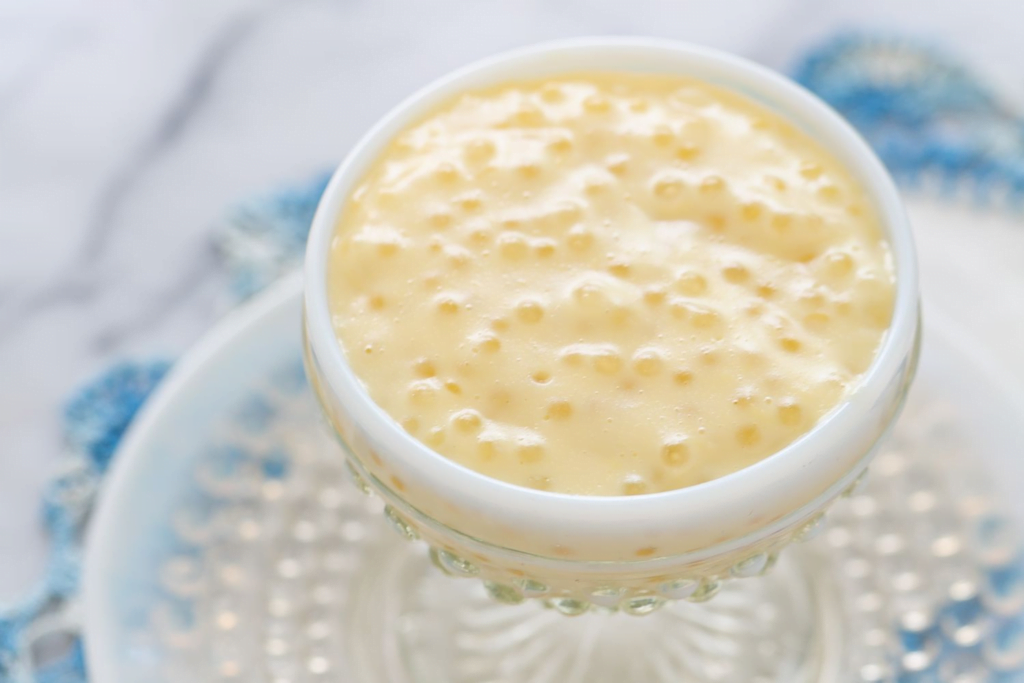
Let’s chat about a local favorite—Sago Pudding, also known in Tok Pisin as ‘Saksak’. The history of Sago Pudding is intertwined with the daily life of Papua New Guineans. Sago, extracted from the trunks of sago palms, is a staple in the local diet and takes a sweet turn in this pudding.
Traditionally, it’s a communal dish, often enjoyed during village celebrations or as a sweet ending to a hearty meal.
Papua New Guinean Cuisine Ingredients for Sago Pudding
- 1 cup sago pearls
- 2 cups water for soaking
- 1 cup coconut milk
- 1/2 cup of sugar, or to taste
- 1 ripe banana, mashed
- A pinch of salt
How to prepare Sago Pudding
- To make Sago Pudding, begin by soaking the sago pearls in water until they are swollen, which typically takes about an hour.
- Drain the water and combine the sago with coconut milk and a pinch of salt in a saucepan.
- Cook over medium heat, stirring until the pearls become translucent and the mixture thickens.
- Sweeten the warm pudding with sugar and fold in the mashed banana for a natural sweetness and comforting texture.
To serve, spoon the Sago Pudding into bowls while it’s still warm. Garnishing with a few slices of banana on top adds a delightful touch. The ideal presentation should be simple yet inviting, capturing the essence of the tropical ingredients.
Pair the pudding with a light, refreshing beverage, such as a fruity iced tea or a tangy tamarillo juice, to complement the creamy texture.
Papua New Guinean Cuisine – Coconut Milk Pudding
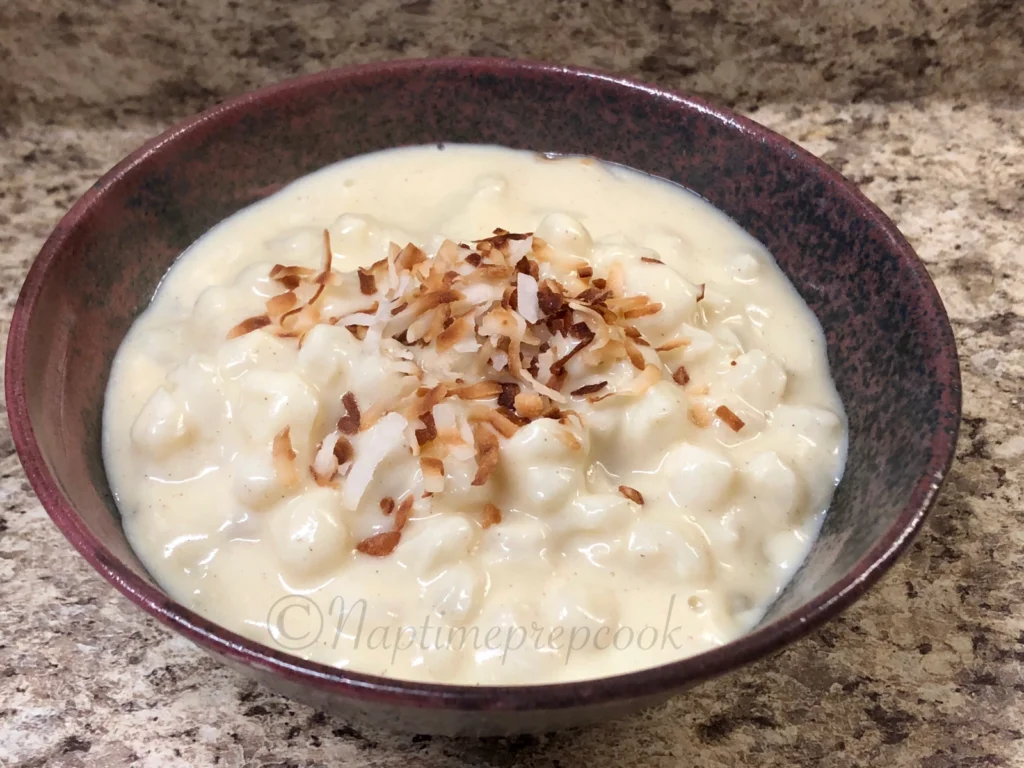
Now, let’s whisk away to another Papua New Guinean treat—Coconut Milk Pudding. This dessert echoes the island’s love affair with coconut, and it’s often found at local markets and family gatherings.
It’s a testament to the versatility of coconuts, which are abundantly available and used in various forms across Papua New Guinean cuisine.
Papua New Guinean Cuisine – Ingredients for Coconut Milk Pudding
- 2 cups coconut milk
- 1/2 cup cornstarch
- 3/4 cup sugar
- 1/2 teaspoon vanilla extract
- A pinch of salt
- Toasted coconut flakes for garnish
How to prepare Coconut Milk Pudding
- Creating Coconut Milk Pudding is quite straightforward.
- Mix cornstarch with a small amount of coconut milk to make a smooth paste.
- Heat the rest of the coconut milk in a saucepan, add sugar, vanilla extract, and a pinch of salt.
- Once the sugar is dissolved, stir in the cornstarch paste and cook until the mixture thickens.
- Pour the pudding into molds or bowls and chill until set.
- Before serving, sprinkle toasted coconut flakes over the top for a satisfying crunch.
When it’s time to present this pudding, go for elegance. Use clear glasses to showcase the layers, and top it with a generous scattering of toasted coconut flakes for a rustic yet chic look.
This pudding pairs beautifully with a cup of strong Papua New Guinean coffee or a sweet pandan tea, balancing the sweet, rich flavors of the pudding.
Conclusion
In the end, the delights of Papua New Guinean cuisine offer a vivid tapestry of flavors and traditions that reflect the nation’s diverse culture and rich history. From the heartwarming stews to the distinctive puddings, each dish tells a story of the land and its people.
As we’ve seen, the cuisine is deeply connected to the natural bounty of the islands, showcasing ingredients like sago, coconut, and an abundance of seafood. Papua New Guinean cooking is a testament to the spirit of community and the celebration of life, with each meal a chance to come together and share in the island’s culinary heritage.
Whether you’re in a bustling market in Port Moresby or a festive gathering in a highland village, the food of Papua New Guinea promises an experience that’s as unforgettable as it is delicious.
FAQ’s
What are the characteristics of Guinean Food?
Guinean food is known for its vibrancy and diverse flavors. Staples include rice, yams, and plantains, which are often served with deliciously spiced stews and sauces. Fufu, a dough-like dish made from cassava or plantains, is also popular. Grilled and smoked fish and meat are common protein sources in Guinean cuisine.
What is a typical breakfast in Papua New Guinea?
A typical breakfast might include fresh tropical fruits, boiled or fried plantains, and sweet potato with tea or coffee.
Are there vegetarian options in Papua New Guinean cuisine?
Yes, with a variety of root vegetables and tropical fruits, there are many vegetarian dishes available.
What’s a common cooking method in Papua New Guinean cuisine?
The ‘mumu’—an earth oven using hot stones—is a traditional method for cooking many dishes.
How does the local geography affect the cuisine?
The abundance of the sea and tropical climate influence the availability of seafood and tropical fruits, key elements in the cuisine.
What are some must-try traditional dishes?
‘Mumu’ pork, chicken pot, and sago pudding are classic dishes that offer a taste of Papua New Guinean tradition.
Is the food spicy in Papua New Guinea?
Traditional food is not typically spicy, but there is often a spicy sambal or chili sauce available to add heat if desired.

